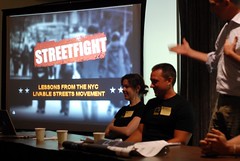
Carfree Conference taking place at Portland
State University through Friday.
(Photos © J. Maus)
With 840,000 motor vehicles entering into New York City’s central business district each day, New York City has its share of challenges in creating livable, safe and people-friendly streets.
But thanks to a burgeoning collaborative effort between advocates and bureacrats, New York City is in the midst of a streets renaissance.
This morning, Carfree Conference attendees got a look inside this renaissance from several leaders of the “livable streets movement”.
In a presentation titled “Street Fight: Lessons from the NYC Livable Streets Movement”, the team behind Streetsblog and Streetfilms (now folded into the Livable Streets Network) shared the latest from the front lines of the battle over public spaces in a city that has been dominated by cars for nearly a century.
Aaron Naparstek, the editor of Streetsblog, said his transportation activism began by throwing eggs at cars. That led him to writing Honku (a collection of road rage haikus), and eventually turned into a career.
Naparstek is the driving force behind a blog that has had a major impact on transportation advocacy not just in New York City, but in many cities and towns worldwide that have been inspired by their work.
Some of what Streetsblog does is similar to BikePortland.org. But unlike this site, they have a team, a stable funding stream (Mark Gorton, who owns file-sharing site Limewire, manages a hedge fund, and founded the Open Planning Project, which Streetsblog is part of), and is much more advocacy-focused.
According to Naparstek they do “advocacy journalism” and they cover “the livable streets beat”. He also laid out other ways Streetsblog (and Streetfilms) has made an impact: highlighting best practices, amplifying the voice of advocacy organizations, framing issues for the mainstream press, supporting political allies, going after the bad guys, making arcane policy more accessible, and mobilizing advocates and community.
Along with sharing information about their work, their “Street Fight” presentation also laid out some interesting statistics.
For instance,
— From 1924 to 1965, the number of car lanes into Manhattan has doubled. Over 1 million cars enter the city each day, yet the number of people entering the city is the same as in 1948!
— There were 271 traffic fatalities in 2007 (23 were bike riders, 136 were pedestrians) and 15,000 pedestrian injuries.
— 26% of the children in Harlem have asthma.
These stats are sobering, but tides are turning in the fight for livable streets. Thanks in no small part to Streetsblog, Streetfilm, and their partners in the Livable Streets Network, New York City’s transportation policy and planning is heading in an exciting direction.
Separated bike lanes, re-visioned streetscapes, traffic safety murals, and streets-friendly Transportation Commissioner Janette Sadik-Khan are all signs of their success.
What’s next for the Livable Streets team?

Project coordinator and technology guru Nick Grossman told us about the launch of Livable Streets Groups. The site allows visitors to join and create a profile, share expertise and experiences, and connect with activists around the world.
An online group for attendees of the Carfree Conference has been set up so they can stay in touch and continue to network and work together after the conference ends.
“We’re trying to work livable streets into a mainstream environmental movement.”
–Lily Bernheimer
Livable Streets team member Lily Bernheimer said they’ve also launched a livable streets education program for public schools in New York City. They plan to put the curriculum and lesson plans online so other school districts can use them.
Bernheimer said, “We’re trying to work livable streets into a mainstream environmental movement… Similar to how recycling used to be fringe, and is now known to everyone.”
Their secret weapon for infiltrating the hearts and minds of school kids will be “Zozo,” the livable streets mascot. “He’ll be like Smokey the Bear was for forest fire,” said Bernheimer.
Check out the Livable Streets Network at LivableStreets.com.
Visit the Carfree Conference page for more coverage or browse through the latest images in the Carfree Conference Photo Gallery.



